In the story of my Everest trek, days 1-4 are merely exposition.
Today we have some rising action and our first crisis. As I’ve hinted, it turns out my guide — young Mingma — isn’t really my guide after all, but just a placeholder until his brother — older Mingma — takes over on day 5. Cue the gasps and a long soap opera tag as the camera pushes in. Dun-dun-dun…
But I don’t find out about this plot twist until afternoon. The day begins with chanting monks in Tengboche, so it’s after 9am — a late start — by the time we set off for our next village, Dingboche.
For the record, today’s views are pretty stellar, too:

That is Ama Dablam peak, which we also saw on yesterday’s trek.
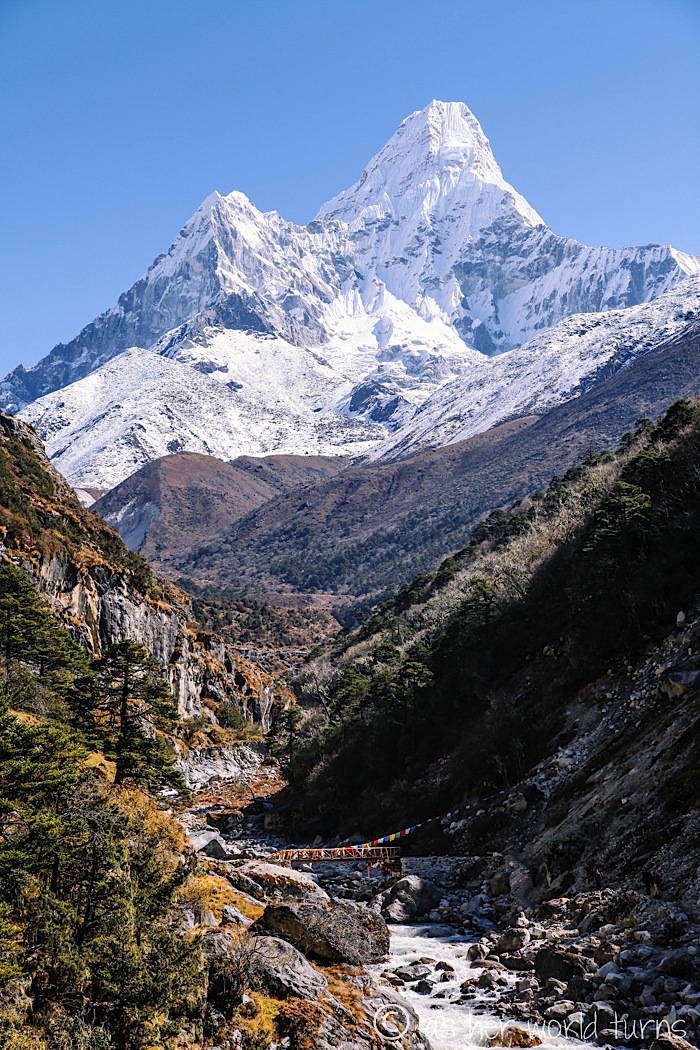

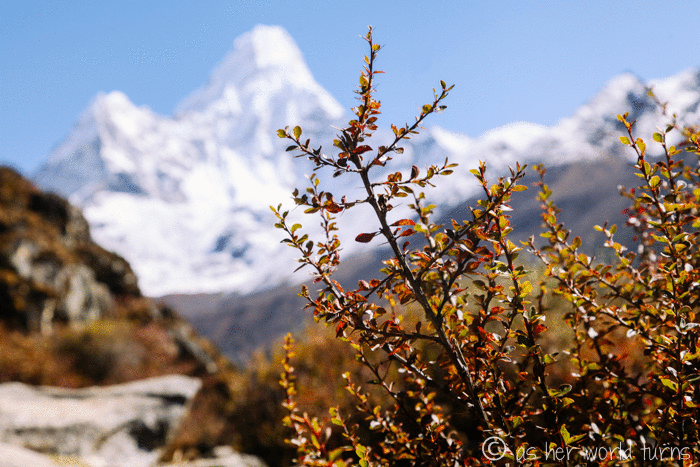
Can you spot the yak below? He blends in well.


More Mani stones line the trail:





Perhaps my favorite photo from the whole trek — bold prayer flags fly over Ama Dablam peak:


Can you make out the hiking trail that cuts across that mountain below? We are tiny specks among giants; we are ants and the mountains are humans.



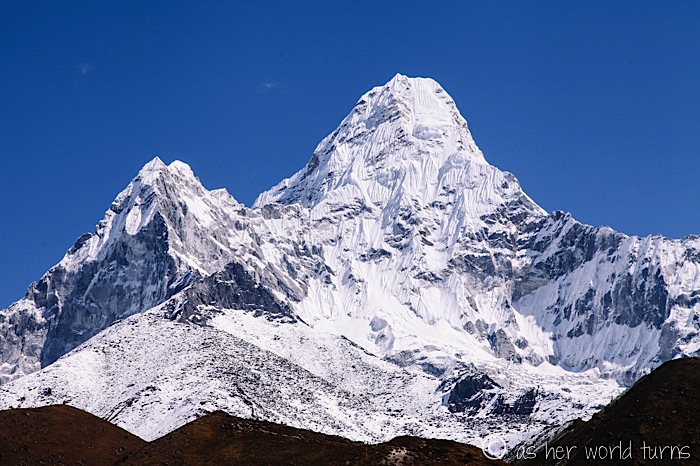
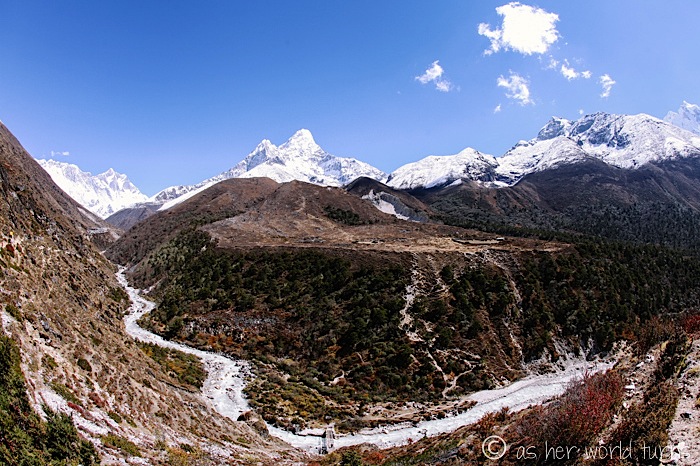


Stir fried noodles with veggies for lunch today. I don’t know it yet, but this is the last day I have an appetite. The next four days my body just wants to eat oxygen, and sadly that’s not on the menu up here.

Afternoon views continue to impress. I’m not even close to being bored with this terrain — bring on more mountains, rivers, clouds, and yaks.





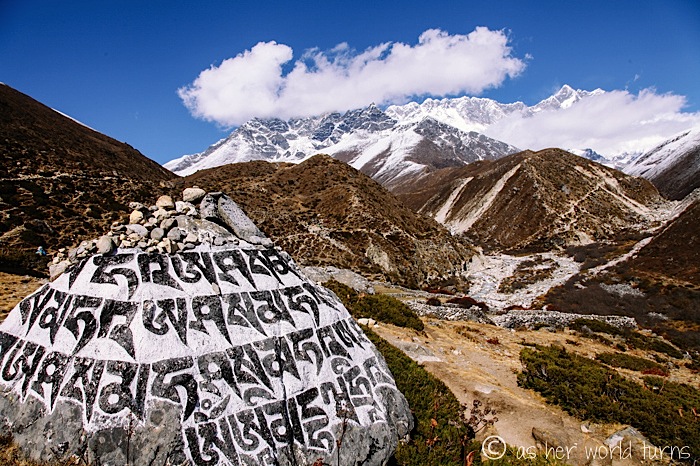




Right after I snap this photo below, I tweak my knee on a stone step and it’s sensitive the rest of the trip.



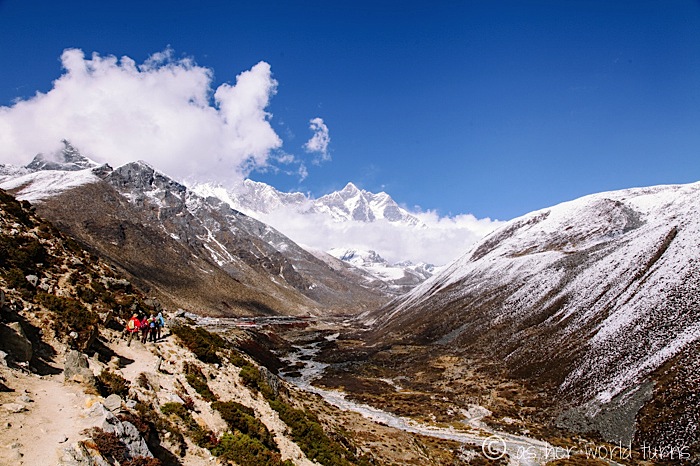

We have made it! This is Dingboche, which rests at 4,530 meters // 14,800 feet. At 300 feet taller than the summit of Mt. Whitney, it’s officially the highest I’ve ever climbed.

Shortly after we arrive at our tea house, I am introduced to the older Mingma. Okay… so now I have a new guide! Not a twist I was expecting, but his English is significantly better than his younger brother’s, so that’s a good sign.
The next complication happens gradually over 24 hours. My appetite goes away. A dull headache sets in. I have trouble sleeping at night, and even my Ibprofin PM doesn’t knock me out like it normally does. These are common effects of mild altitude sickness and most climbers — regardless of age, gender, or physical condition — experience them to various degrees when hiking at this elevation. Simply put, the human body likes to operate with more oxygen than the atmosphere up here provides. While I am not sick — no upset stomach, diarrhea, or nausea — it’s still not pleasant. I’d classify it as a general discomfort that intensifies every day we climb higher.
For the record, I did not take Diamox (a common medicine used for altitude sickness prevention) so perhaps that would have helped. I took it in Peru years ago and actually purchased some cheaply from the grocery store in Thamel just before the trek, but I end up not using it because it’s most effective when taken in the days before going to a high altitude… so I’m too late. Instead I use Ibprofin every 4-6 hours which, in addition to relaxing muscles, acts as a blood thinner so my heart can pump more easily.
But I’m no quitter, so as long as it’s safe, I press on. Day 6 is a rest day and my first time hiking with the older Mingma. He hovers a lot, asking repeatedly to carry my camera bag to lighten my load… no dude, I’m taking photos! And he insists on opening my water bottle for me… again, no thanks, I got it. I stand my ground and we eventually find a balance. We tackle a nearby peak called Nagarzhang. I don’t even get to the very top before turning around — the views are stellar, as you’ll see below, but the hiking is treacherous. There’s mud and snow everywhere and I’m nervous about my choice of footwear (sneakers, not hiking boots, as I explained here). I’m very aware that one slip could twist my ankle or knee and end my bid for Everest Base Camp. I’ve seen the depressed faces of hikers heading downhill atop a donkey, a forced turn-around after an unfortunate fall, or perhaps due to acute altitude sickness. I don’t want to become one of them.
So it’s slow going. The trek takes me 3.5 hours total and, as I mentioned, I don’t even reach the top. Since this hike is just to help my body acclimate to the elevation, I don’t see the need to push myself too far. I turn back when the mud and ice get super slippery.
That said, the views are outstanding… enjoy the photos!




See that white patch of snow below? You can gauge how much higher I climb as it gets farther away in each shot.



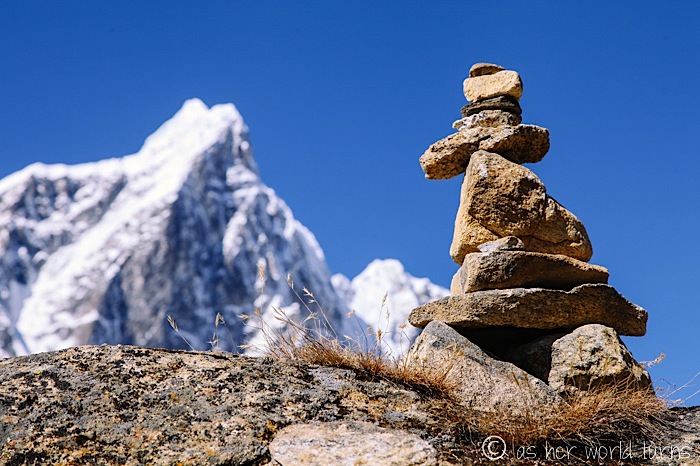
My smile belies my attitude. I’m just not feeling it today.



This is my cold room at the tea house. I use both of those blankets over my sleeping bag and it’s still uncomfortable. I don’t want to think about the freezing nights ahead.

Oh, and by the end of day 6 I’ve officially developed the Khumbu cough:
The Khumbu cough, also known as the high altitude hack, is named after the area in the Everest region, althoughit is not specific to Everest. Nearly all people who spend time at extreme altitude (over 5500m) will develop some degree of the Khumbu cough. It is caused by the low humidity and sub zero temperatures experienced at altitude, and is thought to be triggered by over exertion. This leads to an increased breathing rate, which exposes the delicate lung lining to excess cold air, resulting in dried out membranes and partially damaged bronchi. This causes extreme irritation which manifests itself in the form of a dry, persistent cough which can restrict breathing. Eventually the cough can be so violent and put so much strain on the chest cavity that it causes its victim to tear chest muscles or break ribs. (via)
Prevention includes wearing a balaclava (a ski mask that covers the mouth) to heat and moisturize the air you breathe in and out. This seems sort of gross — like I’m creating my own ecosystem around my neck — but it makes a big difference. And I discover that wearing it while sleeping is crucial to avoid breathing cold air all night long.
I don’t know it yet, but I’ll have this cough for four weeks until I take antibiotics in Israel to kick it out of my system.

This is my dinner, veggie curry with rice. And I try seabuckthorn juice for the first time. It’s made from a local plant and supposedly has significant nutritional value. It tastes okay? I’m not repulsed by it, but it’s quite strong.

I read my book in the main room during the evening — One Hundred Years of Solitude — and then a trekking group invites me to play cards with them. How kind! As a solo trekker, everyone is so nice to me. Hikers regularly strike up conversations during lunch or in the evening, and I’m grateful for their company. Without it I think I’d be lonely. But I never reach that point because of the people I meet along the way.
I win the first several rounds of cards and they joke that it was a mistake to invite me over. My grandma and gramps — the sharpest card sharks I’ve ever known — have taught me well. I can feel Gramps looking down and smiling.
This is where my story continues forward in real time. But I’m going to jump ahead five days and share a handful of images from the trek back downhill through this area, since we return a slightly different way past the lower village of Periche instead of Dingboche. This takes us through a shallow river and then up along the cliffs overlooking a raging river. It’s quite pretty and since it’s in the same vicinity as Dingboche, I’ll share the photos now:



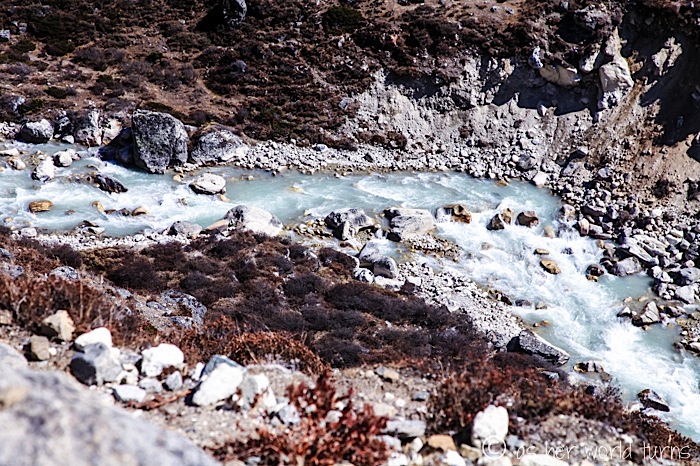




Okay, back to the main action. Will I survive my early signs of altitude sickness, or will things get worse? How will my tweaked knee hold up in the coming days of climbing? Will I get sick of my hovering guide and push him off a cliff?
A literal cliff-hanger. Stay tuned… see you Monday!

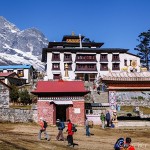
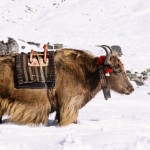
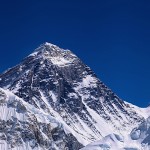
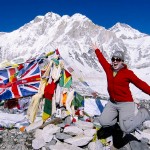
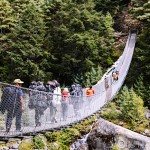

I stumbled across your blog when planning a trip to Australia last year and have been reading ever since. This series you’re doing on Everest is my favorite yet! Thanks for sharing your photos and your travels!
Emily, thank you so much for reading!! I’m so glad you are enjoying the Everest posts. It was fun to put these together and the first time I consulted a hand-written journal from the trek instead of relying on my memory. Thanks for the comment!!